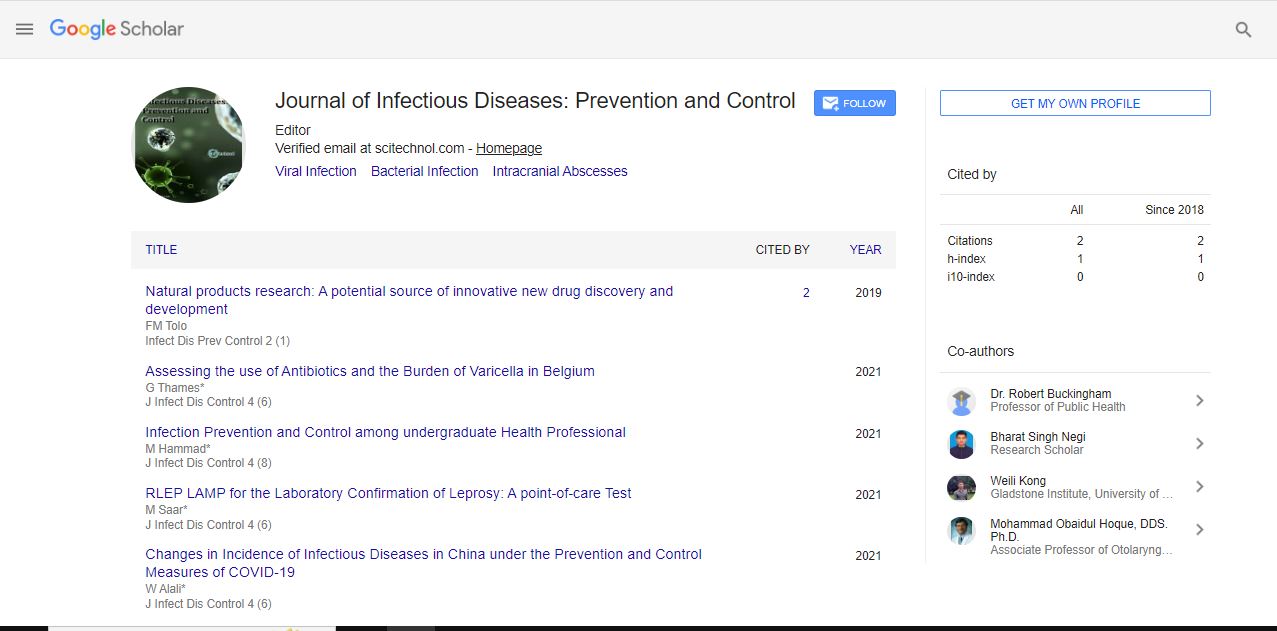Commentary, J Infect Dis Control Vol: 5 Issue: 1
An Audit of the Restorative Potential, Prospects, and Difficulties of CRISPR/Cas9 Genome Altering in the Therapy of Sickle Cell Disease (SCD)
Gwendolyn L Gilbert*
Department of Polygenomics, The University of Sydney, Sydney, Australia
Corresponding Author:Gwendolyn L Gilbert
Department of Polygenomics, The University of Sydney, Sydney, Australia
E-mail:Gwendolyngt@gmail.com
Received date: 31-Jan-2022, Manuscript No. IDPC-22-62162;
Editor assigned date: 02-Feb-2022, PreQC No. IDPC-22-62162(PQ);
Reviewed date: 16-Feb-2022, QC No. IDPC-22-62162;
Revised date: 23-Feb-2022, Manuscript No. IDPC-22-62162(R);
Published date: 02-Mar-2022, DOI: 10.36648/idpc.5.1.111
Keywords: DNA, Sickle cell, Escherichia coli
Introduction
As sickle cell illness is a notable hereditary problem of point change, it is viewed as a main contender for quality altering treatments. Concentrates on distributed in 2016 portrayed an effective evidence of-idea in treating sickle cell illness in mice utilizing the CRISPR-Cas9 quality altering instrument. CRISPR - Cas9 is a programmable RNA-directed DNA endonuclease, which has been acquiring critical consideration over the course of the past 10 years because of its capacity to treat hereditary problems like sickle cell illness. Directed by RNA strand, the Cas9 nuclease-initially detached from microscopic organisms can be customized to cut an objective DNA arrangement and adjusted by embedding, erasing, or supplanting it with the ordinary duplicate of the hereditary succession. However effectively exhibited in mice species, this genome altering device is still in an extremely incipient stage concerning use in the human populace. Through this audit paper, we examine the extension, conceivable outcomes of CRISPR-Cas9 as a possible remedial instrument in the administration of sickle cell infection.
Sickle cell illness or as a contraction (SCD) is an Inherited infection brought about by point changes in the beta-globin quality that helps make (Hb). Regularly, hemoglobin in RBCs takes up oxygen in the lungs and helps it through the corridors to every one of the cells in the tissues of the body. RBCs that contain typical hemoglobin are plate formed and adaptable so they can move effectively through enormous and little veins to convey oxygen. Be that as it may, in the Sickle Hemoglobin (HbS) in contrast to ordinary Hemoglobin (Hb) the changes in the quality lead to issues when oxygen levels in the blood are less, which happens once the hemoglobin has conveyed oxygen to the cells in the body's tissues [1]. With less oxygen, the strange hemoglobin S quality can cause unbending, non-fluid protein strands to frame inside the RBCs which at last lead to the adjustment of the state of the cell making it sickle-formed which are not adaptable and stick to vessel dividers, making blockage the progression of the blood. At the point when this occurs, a satisfactory measure of oxygen doesn't arrive at the foreordained tissues. This absence of supply makes up the etiology for serious torment known as 'emergencies' which is in many cases found in patients with SCD. Because of the obvious change in morphology of the RBCs, they will quite often burst up effortlessly followed by a decrease in life span by 10-20days from standard 90 days-120 days. Besides, the quantity of RBCs is lower than common which prompts the condition in the patients called Anemia with less energy and feeling shortcoming and laziness in patients. Hereditarily talking, in Homozygous circumstances RBCs of SCD patients produce HbS and need HbA on the grounds that they acquire two alleles of the HbS quality. In actuality, individuals with the heterozygous show (SCT) Sickle Cell Trait with the single allele of both the HbS and HBB quality and generally don't encounter side effects of SCD because of the conjunction of typical HbA and HbS in RBCs. Currently, an allogeneic bone marrow relocate is the main possible way to deal with fix SCD However, in clinical work on, finding a reasonable contributor is troublesome and the allogeneic marrow relocate technique has genuine dangers, including patient demise thinking about this, the helpful reasoning to treat SCD patients can be established on the transformation of SCD to SCT genotype by means of genome altering of HbS/HbS to HBB/HbS. Bunched routinely interspaced short palindromic rehashes (CRISPR) and CRISPR-related (Cas) qualities were at first found in Escherichia coli In 2007, Barrangou et al. exhibited that incorporating a genome section of an irresistible infection into its CRISPR locus presented Streptococcus thermophilus obstruction against a bacteriophage. In 2012, Jinek et al. shown the limit of the CRISPR/Cas9 framework to perform RNA-modified genome altering. This methodology for genome altering has been concentrated in an assortment of creatures like microscopic organisms, yeast, Drosophila, Zebrafish, plants, monkeys, pigs. These discoveries give a strong groundwork to treat SCD by genome altering of patient HSPCs utilizing the CRISPR/Cas9 approach.
 Spanish
Spanish  Chinese
Chinese  Russian
Russian  German
German  French
French  Japanese
Japanese  Portuguese
Portuguese  Hindi
Hindi 